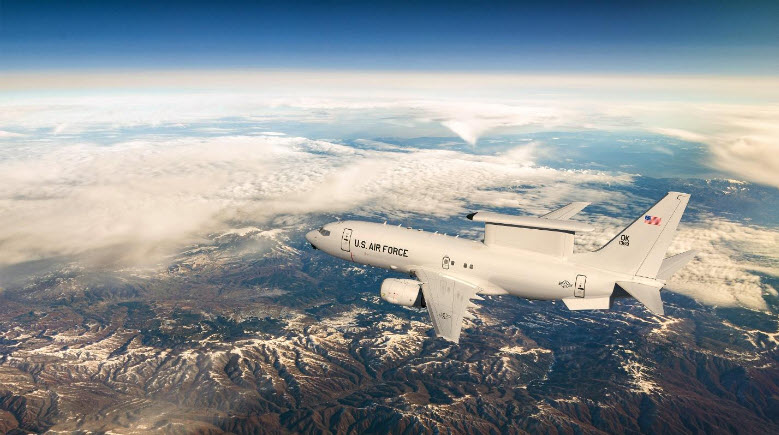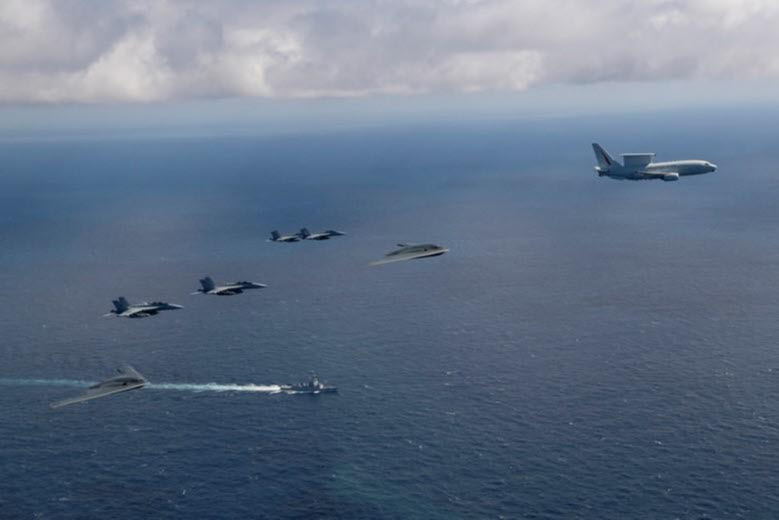
An artist’s depiction shows the E-7A in flight. The E-7A will allow the U.S. Air Force to retain air dominance for decades to come. (Boeing image)
For decades the U.S. Air Force has relied on the aging E-3 to keep up with new threats. Today, replacement parts are more difficult to procure, and the mechanical breakdowns inherent in such an old aircraft are impacting mission rates. In the most recent budget, Congress appropriated an additional $200 million for the Air Force to develop an E-3 replacement strategy – enter the E-7.
On the 21st century battlefield, connectivity is key to closing the kill chain through more-informed, faster decisions. The future battlespace requires a new approach. One that is centered around operational capabilities that function across all domains at greater speed, both physical and cognitive.
Now is the time to modernize its Airborne Early Warning and Control (AEW&C) capabilities and to capitalize on the latest technologies that will enable the U.S. to deter conflict and project power against any and all threats.
E-7 answers the call. Manufactured by prime contractor Boeing, the E-7 is a mission-proven solution ready to meet the U.S. Air Force’s and allies near-term E-3 replacement needs while addressing Operational Imperative capability requirements such as operationally focused Advanced Battle Management System capabilities, moving target engagement and tactical air dominance. As a derivative of Boeing’s Next-Generation 737 and in operation with U.K., Australia, Korea and Turkey, E-7 testing and evaluation will provide the warfighter with a measurable operational advantage.
“We See You” – AN INTEGRATED COMMAND AND CONTROL NODE IN THE SKY ENABLING JOINT OPERATIONS
As the USAF gradually phases out its E-3 fleet, the E-7 will not only fill that capability gap, but it will also bring new multi-domain capabilities at the tactical edge, allowing an asymmetrical advantage over threats. In February, the U.S. Air Force awarded Boeing an Undefinitized Contract Action contract to begin development of two new U.S. E-7 Airborne Early Warning & Control (AEW&C) aircraft.
Andrew Hunter, the U.S. Air Force’s assistant secretary for acquisition, technology and logistics, commented: “This contract award is a critical step in ensuring that the Department continues delivering battlespace awareness and management capabilities to U.S. warfighters, allies and partners for the next several decades. The E-7A will enable greater airborne battlespace awareness through its precise, real-time air picture and will be able to control and direct individual aircraft under a wide range of environmental and operational conditions.”
Recently, Boeing conducted a virtual demo from its Joint All Domain Command lab that successfully combined data from multiple platforms across domains to create a common operating picture. The open mission systems-heavy E-7 was the primary platform in the simulated scenario, sharing data and common operating pictures between multi-domain systems – from sensor to sensor, to platform, to shooter.
Next-generation capabilities like these will allow the warfighter to collect, process and share critical information for better, faster decisions, more than ever before.
As an integrated, flexible command and control node, the E-7 brings unparalleled abilities to scan the skies, communicate with surface, ground and air assets and enable integration across the joint force. Its networked connectivity, edge processing, organic communications and sensor data generation deliver beyond-line-of-sight connectivity for significantly improved operational decisions and resilient and efficient force employment – all critical elements in maintaining air dominance.
“The E-7 will provide a modern and considerable upgrade in capability from the aging E-3 Sentry. And its use of modular open systems architecture will allow its software-oriented radar systems to be regularly upgraded. The capability is impressive. It’s a night and day difference.” – Andrew Hunter, assistant Air Force secretary for acquisition, technology and logistics, US Air Force says options limited for speeding deliveries of Wedgetail, Jul. 17, 2022.

Photo: Pacific Air Forces Public Affairs
E-7 FEATURES UNPRECEDENTED INTEROPERABILITY, READINESS & RELIABILITY
The E-7, a derivative of the in-production Next-Generation 737, represents an affordable mission-ready platform that brings capabilities and higher mission readiness rates on day one. Boeing’s proven commercial derivative aircraft design, complex FAA certification and modification processes are established, meaning the advanced platform can be fielded for sooner mission deployment.
“We see tremendous opportunities to begin test and evaluation, given that we’re buying a system very similar to the U.K. E-7. Much of the testing can actually be done on a U.K. E-7 or a Wedgetail, so tremendous opportunities, especially with test and evaluation.” – Steven Wert, Program Executive Officer Digital, Air Force Life Cycle Management Center, Air Force PEO Looks to Speed Up Program Start, Testing for Wedgetail, Aug. 11, 2022.
Integration in future coalition operations is also an advantage, with the E-7 in service or on contract with Australia, South Korea, Turkey and the United Kingdom. Each of these countries has seen firsthand what this aircraft is capable of in terms of serving as a force multiplier in degraded and contested environments.
As a military derivative of the in-production Boeing Next-Generation 737-700 commercial aircraft, the E-7 has access to a well-established global supply chain that brings lower operating and sustainment costs, higher mission readiness rates and unmatched interoperability among a growing global user community.
With 9,000+ worldwide 737s that include 30 global repair facilities and 250 global service centers, the E-7 benefits from significantly reduced maintenance and logistics costs.
E-7 IS DESIGNED TO EVOLVE
We can’t predict what future technologies our nation’s threats will possess. Therefore, we can’t really determine the specific capabilities the aircraft will need to overcome them. However, we can develop aircraft in a way that enables rapid, seamless and affordable technology insertion to remain ahead of those threats.
“The E-7 in my opinion is probably the single most important piece in terms of its capabilities in the future for the air superiority fight.” – Christopher Niemi, PACAF’s director of strategy, plans, programs, and requirements, The Search To Replace The Air Force’s Geriatric E-3 Sentry Radar Jets Has Officially Begun, Feb. 2022.
Through its open systems architecture and agile software development, the E-7 provides rapid, affordable capability growth to remain a critical asset as threats evolve. Its design enables continuous updates, giving the customer the flexibility to use either Boeing or third-party software to maximize the warfighter’s capability to rapidly upgrade or field new technologies regardless of vendor.
THE THREAT WON’T WAIT
The threat won’t wait – and neither should USAF in modernizing its AEW&C capabilities.
Boeing’s E-7 is the only mission-ready, affordable solution that is immediately able to meet the U.S. Air Force’s near-term E-3 replacement needs while also addressing their long-term capability requirements – ultimately helping to preserve this nation’s Air Superiority for decades to come.





















